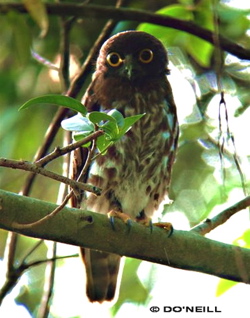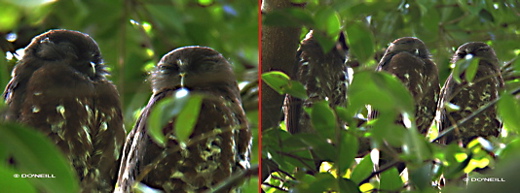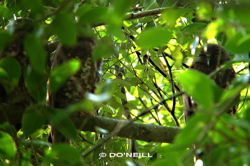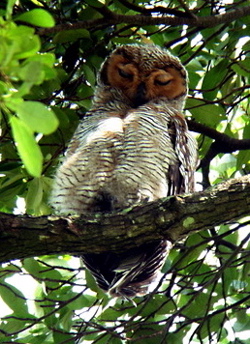There are 23 SE Asian species of typical owls that befit the description of nocturnal birds with rounded heads, large forward-facing eyes circumvented by feathered facial discs. Their plumage mostly brown and cryptically patterned, they hunt by night and roost by day.
While their roosting hide-outs are difficult to find, bird watchers at times when lady luck visits, do accidentally run into them.
Thus, finding a night bird in daylight hours is not only an infrequent encounter, the ability to digiscope them with no flash photography allows the bird to continue sleep without rudely being awakened. Such images are valued and carry good credits. That’s my opinion anyway and for which I am generous to show in image but not to be asked at source.
The Brown Boobook (Ninox scutulata) previously known as Brown Hawk Owl, decided to give me that privilege in one of my birding trips.
I was unable to tell the sex of owls but this 30cm bird suddenly flew in and perched on a low tree canopy. At 10 feet away, the Brown Boobook was head gyrating and sizing me up with its golden-yellow eyes (above).
“Oh.. I don’t know this bird and it is a lifer to me.”
Armed with birding luck which seems remain in eternity with me, the second bird showed up. As though not enough…. the third flew in and perched beside each other.
Soon, I was digiscoping three sleepy maids in a row (above).
Then…. beyond the wildest dreams of any birder who would dare ask for the fourth, this cute ‘Johnny 4’ showed up to make a foursome (right)!
What can I say more but sighting Pittas and Trogons that showed in twos and threes paled in comparison with encounter of this fourth kind.
I remembered being told that some birds sleep with their eyes opened. Now I am able to bring those bird eyes closer to readers to see for themselves if it is true.
The white covering over their eyes are called nictitating membranes. They help to protect the eyes and from drying out while birds sleep. At the same time, by keeping an opening eye or eyes opened, birds remain watchful for predators in their sleep.
To sleep-wink at readers, let me introduce Natasha – the juvenile Spotted Wood Owl (Strix seloputo) as the closing sleeping bird image that looks like a Russian doll (left).
Good night baby!
DAISY O’NEILL, AVIAN WRITER, PENANG, MALAYSIA.













3 Responses
wow, what beautiful birds!
Are any of these owls getting close to extinction?
The owls in Singapore are either common/uncommon/rare residents or rare winter visitors.
I have to go all the way to Singapore to see these guys? damn!